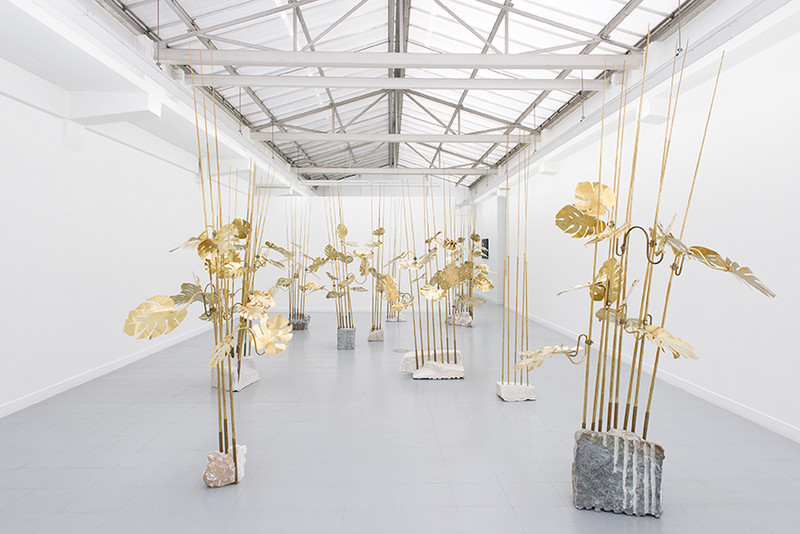Elaine Cameron-Weir
13 Sep - 25 Oct 2014
ELAINE CAMERON-WEIR
MEDUSA
13 September - 25 October 2014
Houseplants are transitional objects. They temper our entry into interior spaces, ripening the domestic space for scenes of both action and repose while leaving the curious impression that they are privy to much more than your average flourish of decoration. Houseplants are, after all, alive; they are mortal beings existing simultaneously as both décor (in the Broodthaersian sense of the word), and actors within décor. That, and they make great ashtrays at parties.
For her second exhibition at Galerie Rodolphe Janssen, Elaine Cameron-Weir will present a series of sculptures in brass and marble. Like an establishing shot just before an actor walks onto a scene, Cameron-Weir’s oeuvre thrives on latency, on creating a mood, on populating a stage for something to occur.
Here, Monstera Deliciosa leaves rise unnaturally from curved brass poles grounded in unfinished chunks of quarried stone, conjuring images of Art Nouveau hotel lobbies as much as gnarled fragments of demolished buildings (with metal rods from reinforced concrete jutting out like blades of grass through cracked pavement). And yet, even as referentiality threatens to manifest, so Cameron-Weir’s work coyly side-steps representation, instead negotiating a fragile balance between materiality and function. Modular details - elements that allow the sculptures’ leaves to scale up and down their brass stems - produce a longing for utility, to stray from the seeming obsolescence of the art object and its representative capacity and simply become functional objects: A lamp, say, or maybe a coat rack. In this way, Cameron-Weir’s sculptures undergo a form of mimetic transformation, from nature, to captive nature, to design object, to art object, and back again.
This position between a desire for utility and a desire for sensuousness - for objects to simply create a mood whether they perform a role or not - underlines the beautifully quiescent (or perhaps prescient) atmosphere in Cameron-Weir’s work, one as hopeful as it is nostalgic. Just as houseplants will never root themselves into an apartment floor, so Elaine Cameron-Weir’s works function by maintaining a tension between what they are aware of, and what they might attain.
Bitsy Knox
About the artist :
Elaine Cameron-Weir (1985, Red Deer, Canada) lives and works in New York City. Recent solo exhibitions include Venus Over the Sun at Desaga (Cologne), and Venus Anadyomene and Not known to be used by any form of life at RAMIKEN (New York). She has also participated in recent group exhibitions at Croy Nielsen (Berlin), Bortolami (New York), Martos Gallery (New York), Nicelle Beauchene Gallery (New York), Art Concept (Paris) and GAMeC (Bergamo)
MEDUSA
13 September - 25 October 2014
Houseplants are transitional objects. They temper our entry into interior spaces, ripening the domestic space for scenes of both action and repose while leaving the curious impression that they are privy to much more than your average flourish of decoration. Houseplants are, after all, alive; they are mortal beings existing simultaneously as both décor (in the Broodthaersian sense of the word), and actors within décor. That, and they make great ashtrays at parties.
For her second exhibition at Galerie Rodolphe Janssen, Elaine Cameron-Weir will present a series of sculptures in brass and marble. Like an establishing shot just before an actor walks onto a scene, Cameron-Weir’s oeuvre thrives on latency, on creating a mood, on populating a stage for something to occur.
Here, Monstera Deliciosa leaves rise unnaturally from curved brass poles grounded in unfinished chunks of quarried stone, conjuring images of Art Nouveau hotel lobbies as much as gnarled fragments of demolished buildings (with metal rods from reinforced concrete jutting out like blades of grass through cracked pavement). And yet, even as referentiality threatens to manifest, so Cameron-Weir’s work coyly side-steps representation, instead negotiating a fragile balance between materiality and function. Modular details - elements that allow the sculptures’ leaves to scale up and down their brass stems - produce a longing for utility, to stray from the seeming obsolescence of the art object and its representative capacity and simply become functional objects: A lamp, say, or maybe a coat rack. In this way, Cameron-Weir’s sculptures undergo a form of mimetic transformation, from nature, to captive nature, to design object, to art object, and back again.
This position between a desire for utility and a desire for sensuousness - for objects to simply create a mood whether they perform a role or not - underlines the beautifully quiescent (or perhaps prescient) atmosphere in Cameron-Weir’s work, one as hopeful as it is nostalgic. Just as houseplants will never root themselves into an apartment floor, so Elaine Cameron-Weir’s works function by maintaining a tension between what they are aware of, and what they might attain.
Bitsy Knox
About the artist :
Elaine Cameron-Weir (1985, Red Deer, Canada) lives and works in New York City. Recent solo exhibitions include Venus Over the Sun at Desaga (Cologne), and Venus Anadyomene and Not known to be used by any form of life at RAMIKEN (New York). She has also participated in recent group exhibitions at Croy Nielsen (Berlin), Bortolami (New York), Martos Gallery (New York), Nicelle Beauchene Gallery (New York), Art Concept (Paris) and GAMeC (Bergamo)

